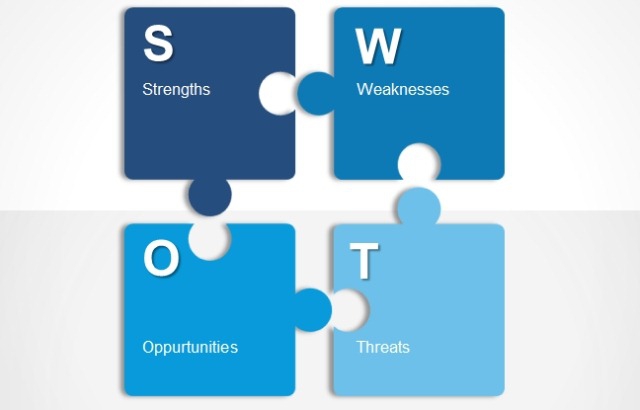Among the popular research methods used in a wide range of disciplines - marketing, sociology, economics, there is a SWOT analysis. Its key feature, prescribed by many experts, is universality.
You can conduct a SWOT analysis of a company, LLC, or even a non-profit enterprise. The results in all cases will be very useful from the point of view of the development prospects of the institution. At a minimum, “white spots” will be identified that are characteristic of the current policy of managing a business or non-profit organization.
SWOT Analysis: Theory

A SWOT analysis is a study of an object according to four main criteria. S is his Strengths, W is Weaknesses, O is the opportunity created by the environment, T is the possible threat, also determined by environmental factors. SWOT analysis is a fairly universal methodology. If you use it, you can evaluate the prospects for the development of businesses, non-profit projects, and, if desired, individual states.
Consider the main varieties that represent the SWOT analysis. Experts identify the two most common.
- Fast SWOT analysis. This method of researching an object is limited to listing key factors that reflect its strengths and weaknesses, as well as the opportunities and threats that are formed by the external environment. The practical value of this type of analysis is very limited: it is advisable to use it, if, for example, the task is to familiarize the audience with a SWOT technique that knows nothing about it.
- In-depth SWOT analysis. This method, in turn, differs much more in comparison with the previous detail of studying the properties of the object. The main advantage that this method of SWOT analysis possesses is the ability to predict (simulate) further changes reflecting each of the four criteria. That is, not only an assessment of the weaknesses and strengths of the object, characteristic of the current moment, but also the calculation of possible changes in them in the future is given.
Attempts to combine these two models are possible. Moreover, as some experts emphasize, in many cases the SWOT methodology is not presented in its pure form by a “quick” or “in-depth” format. As a rule, it occupies an intermediate position, the characteristics of which depend on how much the researcher himself decided to study the sides of the object.
SWOT analytics in business

Among the areas in which the applicability of the SWOT method is most justified is entrepreneurship. The fact is that business is a type of activity where all four types of criteria mentioned by us above are traced, as many experts believe, very clearly.
For example, each company has strengths (compared to competitors). Otherwise, the product that is produced by the company would not be in demand by the market. Also, a company’s strength can be a product that it doesn’t release, but also, for example, some experience, expertise, and qualifications of specialists working in the business.
In turn, all businesses have weaknesses. In particular, this may be insufficient technological processes or low productivity.
Businesses always interact with the external environment - they sell something somewhere, contact with suppliers, competitors, and the state. Accordingly, they are very susceptible to various kinds of threats.Such as, for example, the sudden overlap of important supply channels, a change in the tax regime, political crises, etc.
Finally, the success of a business almost always depends on the opportunities provided by the external environment. They can be manifested in so many aspects. For example, the low saturation of a niche is, of course, an opportunity. Low taxes, too. Salary growth for targeted consumer groups is similar.
Why does an entrepreneur need a SWOT analysis?
A SWOT analysis of a commercial type organization is very useful for its owners in terms of shaping the right business strategy, experts say. This kind of methodology will help companies at any stage of development, as well as in a variety of market conditions.
A SWOT analysis of an enterprise is an example of a methodology that will always provide some kind of guidance for action - it cannot be such that the company has only weaknesses, it is also unlikely that the environment will carry mainly threats. There will certainly be some internal competitive tools, and in the external environment, factors that have a positive impact on the business will be discovered.
Internal and external criteria
Experts studying the practical application of the SWOT analysis strategy recommend distinguishing between external and internal criteria as clearly as possible. Which, respectively, include threats and opportunities of the environment, as well as the strengths and weaknesses of the object. The main distinguishing feature here is that external criteria reflect processes that are not directly controlled by the facility.
For example, if we try to conduct a SWOT analysis of a travel agency, then, for example, a clear external factor will be the policy of issuing visas by the states where the company sends its customers. If it becomes obvious that the firm can still influence certain phenomena in the external environment, this option automatically becomes its strength. And therefore, this factor will be part of the internal criteria.
Adequate assessment of criteria
It cannot be considered that some aspects of the object are strong, while others are weak only because of the subjective perception of them as such by the person who conducts the SWOT analysis. Example: Narcissus sells vegetables by purchasing them from suppliers in Hungary under an exclusive contract. Farmers from this Eastern European country send excellent quality fruits to Russia at a very low price.
This allows the company "Narcissus" to make good money and maintain a stable business. The marketing director of this company praises the management, saying that Narcissus (and showing documents that set out the SWOT analysis) is an example of a successful, developing company due to an amazing contract with Hungarian partners. In this director’s study, an agreement with Europeans is seen as a business strength.
Six months later, for no reason, the company's revenue falls sharply. What's the matter? It turns out that the main competitor of Narcissus, for example, the company Buttercup, was able to conclude a contract for the supply of vegetables from China - of the same quality, but at a much lower price. As a result, they managed to build more efficient business processes and reduce the selling price of products.
The buyer went to Buttercup. In turn, Narcissus could not restructure its business processes so as to become competitive. It turned out that the contract with the Hungarians was not at all a strength, but a weakness of the company. Management needed not to admire the director’s report, which made an “amateur” SWOT analysis of the store, but to urgently find new suppliers.

Practical SWOT analytics: production and sale of furniture
Using the example above, we were convinced that when conducting a SWOT analysis, it is necessary to very carefully evaluate the belonging of certain factors to specific criteria. We saw that there can be a very thin line between the strengths and weaknesses of an organization.Now we will look at examples that reflect the company’s SWOT analysis for all four criteria.
We have already discussed the sphere of food retail. Consider now the option with the furniture segment. Let it be, for example, a small regional factory "Birch Grove" and a store with it.
Experts consider it legitimate to highlight the following strengths for this type of business that are most characteristic of a successful company in the furniture production and retail segment:
- Qualified designers on staff. As a result, a resource is formed to stimulate demand for own products by setting new fashion trends.
- Local wood suppliers. Therefore, low costs for the delivery of raw materials for furniture production.
- Recognizable brand. As a result, stable demand without mandatory investment in advertising.
In turn, the weaknesses most characteristic of furniture enterprises can be represented by the following combination:
- Outdated equipment. As a result, insufficiently high labor productivity.
- Only one store, and that one is located on the outskirts of the city. Consequently, many target customers are unavailable.
- The main production facilities are located in leased premises. It may happen that the owners ask for them a prohibitive price - and the business will be unprofitable.
Among the examples reflecting the positive environmental factors characteristic of furniture business, experts distinguish the following:
- Lack of competitors in the market - prospects for active business growth.
- High salaries for customers - market readiness for the purchase of premium furniture.
- Cheap electricity - low production costs.
Factors that may reflect environmental threats to furniture enterprises may be:
- The company operates in the province. "Cool" designers can be lured to higher salaries by capital furniture brands.
- A shortage of furniture masters in the region. This means a lack of opportunities to increase production volumes.
- The ambiguity of the state’s position on the issue of pension deductions from salaries can increase the amount of payments to the PFR and the Social Insurance Fund at any time — the likelihood of a sharp drop in the profitability of the output of goods.
What are the practical benefits that a SWOT analysis of an enterprise can bring us, an example of which we just examined? This can be expressed in so many aspects. The most important thing is that the management of the company will see by eliminating any weaknesses the company can take a decisive step forward in its development. Similarly, all relevant negative environmental factors will be considered.
After conducting a SWOT analysis of the enterprise using the example of a furniture manufacturing enterprise, we can try to consider other business sectors. For example, the banking sector. Suppose that we need to analyze a small, also regional, credit and financial institution of JSCB Severny Capital.
Practical SWOT analytics: bank
So, we carry out a SWOT analysis of the bank. The most characteristic strengths for a successful bank, experts include the following:
- High level of service. Clients will go to the offices of a financial institution more willingly than competitors (although they are represented by the most famous federal brands), bring more revenue.
- Large customer base: more deposits, loans, more active use of related services.
- Highly qualified staff: less risk when issuing consumer loans.

The factors that can characterize the bank from a weak side, experts include the following:
- A small number of offices and ATMs - insufficient coverage of the client audience.
- A turnover of specialists who prefer to move to large cities (we quoted above by conducting a SWOT analysis of the store, an example of a similar trend in the field of personnel when qualified designers move to larger cities).
- Not enough brand recognition. Many customers who come to the city are afraid to go to an unknown bank and go to competitors who are more popular at the federal level.
A small regional bank may be characterized by the following opportunities formed by the external environment:
- Bureaucratization of competitors representing interregional or even international networks: better adaptability to regional business conditions.
- High customer salary: more loans, deposits, purchases of premium plastic cards.
- Loyalty of local businesses: revenue growth due to settlement and cash services for enterprises.
Possible threats to banks arising at the level of the external environment may be:
- Political instability: risks associated with liquidity, inability to borrow abroad.
- Non-payment of loans due to economic factors: lack of funds to fulfill obligations to the Central Bank and own creditors.
- The possibility of tightening financial legislation - if the Central Bank does not meet the new criteria, it can revoke the license.
How will the SWOT analysis help bank management? First of all, top managers of a credit institution will understand the details of doing business that can optimize the positioning of the financial structure in the market. There will also be an opportunity to improve organizational processes within the bank itself.
Practical SWOT analytics: cafe
Having analyzed the financial and credit organization according to four criteria, we consider another area. Among the most significant business sectors for the Russian economy is catering. We will carry out a SWOT analysis of the cafe. Let us agree that it is also provincial. Let it be called Lyric.

Among the strengths characteristic of a modern cafe, experts name the following:
- Excellent quality of food, a high level of service - this, in fact, is all that a client needs, people will go to this cafe.
- The best chefs of the region work in the organization, which allows you to create a new assortment and use exclusive recipes: more clients of different ages, social affiliations.
- Large hall area: the opportunity to work not only in the usual format, but also to hold holidays, corporate parties.
What can be the weaknesses of Café Lyrica:
- Staff turnover (like a regional bank and a furniture store, as shown by the SWOT analysis, registration of long-term labor relations is a problem).
- The premises where production and reception are organized are rented: prices can rise, business profitability can decrease.
- A limited circle of suppliers: if someone goes bankrupt, many dishes will be impossible to cook.
Among the market factors conducive to the development of cafes, the following can be observed:
- Low level of competition in the city: there are always customers.
- High salary of the target consumer group: a large "average check".
- Construction of new office buildings in the cafe area: an increase in the number of customers in the daytime (people will come to dine).
Possible threats to the development of the cafe due to the external environment:
- Changes in the sanitary and epidemiological legislation: frequent inspections, costs of compliance.
- Crisis phenomena in the banking system: difficulties in obtaining loans for business development.
- Inflation: a rise in price of ingredients, a decrease in profitability.
The catering business is very competitive. SWOT analysis has every chance of becoming an instrument for improving the key factors affecting the market position of the institution.The ability to find strengths and weaknesses in the business model is the most important condition, according to many experts, for the entrepreneur to adapt to the competitive environment.
Practical SWOT Analytics: School
The four-stage SWOT analysis matrix is an example of a very universal methodology for studying objects. We can explore the properties of not only businesses, but also other organizations. For example, it is quite realistic to adapt our methodology to the study of a regular institution for secondary education. Now we will conduct a SWOT analysis of the school.
Let it be a municipal institution No. 25 with in-depth study of the German language, located in the same small provincial town as the Birch Grove store, Severny Kapital bank and Lyrika cafe. The criteria for the school are the same that we used by conducting a SWOT analysis of the enterprise using the example of a commercial type enterprise. Namely: strengths and weaknesses, determined by internal factors, as well as opportunities and threats - they, in turn, are determined by the external environment.

What kind of strengths could we highlight in the middle educational institution? Experts identify the following (characteristic for this aspect) indicators:
- Experienced teachers: a high level of student training, as a result - a possible priority in funding from the municipal authorities.
- Resources for extracurricular development (computer courses, driving instruction, university preparation, etc.): school recognition in the city, prestige.
- Positive relationships in the teacher team: the ability to implement programs of any complexity, coordinate the implementation of plans (including those set by higher governing structures).
Weaknesses that may be characteristic of the school:
- Too strong a bias in the curriculum for language disciplines: a relatively small percentage of students will become linguists, talented students could be more in the humanitarian and applied fields.
- Lack of balanced schedules: children do not have enough free time for extracurricular activities in libraries, sports clubs, and circles.
- Ineffective distribution of financial resources: a lot of equipment of one type is purchased, in short supply are other items needed in studies.
Environmental factors that can play a positive role for the development of the school:
- Intensive cooperation between the Russian Federation and Germany: the demand for people who know the German language.
- Great state attention to the development of school education, the growth of teachers' salaries: an influx of new personnel.
- Lack of other specialized language educational institutions in the city: concentration of budgetary resources allocated by the municipality for teaching children foreign languages.
Environmental factors that may play a negative role regarding the prospects of the school:
- Despite the increase in salaries, there are not enough personnel: training programs are difficult to implement from year to year.
- Frequent changes in state educational standards (there is, for example, the possibility that the USE will be canceled or recommended not to be held in specialized language schools): due to a shortage of personnel, an educational institution may not be able to cope with the restructuring of training programs.
- The tendency to transfer the school to market rails by giving it the status of an autonomous institution: the lack (or even the absence) of specialists with entrepreneurial experience can complicate the financial situation of the school.
Versatility of SWOT Analysis

We have just seen how unique the SWOT analysis is: the fields of its application are very wide. We realized how useful it can be for entrepreneurs. We looked at how you can study the SWOT-criteria in relation to different business areas.
It can be assumed that the SWOT analysis of an agricultural enterprise can be no less useful.An example of the compatibility of this methodology with non-profit organizations (such as a school) we also examined.
Subsistence farming is, of course, more of a business. Four criteria, the impact of which on business prospects, we studied, are also quite relevant for the agricultural industry. There is a complete compatibility of SWOT-methods with the study of external and internal factors affecting the development of objects that are involved in this field of activity. This once again proves the universality of such a tool as SWOT analysis.








